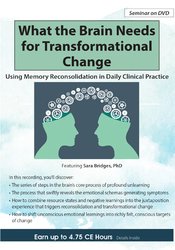

Neuroscientific advances in memory reconsolidation enable us to achieve therapeutic breakthroughs with previously unheard of consistency. In this workshop, you’ll learn how to engage the neural process that decommissions implicit learnings that drive PTSD, compulsive behaviors, and insecure attachment. You’ll see how reconsolidation underlies the effectiveness of a wide range of therapies and is key to transformational change. Videos and live demonstration will show you how to mobilize the brain’s power to unlock and dissolve long-entrenched schemas, ego states, and emotional conditionings. You’ll discover:
**This recording is intended only for mental health professionals and trainees.
| File type | File name | Number of pages | |
|---|---|---|---|
| ZNM052875 (2.60 MB) | 16 Pages | Available after Purchase |
Bruce Ecker, M.A., L.M.F.T., is codirector of the Coherence Psychology Institute and coauthor of Unlocking the Emotional Brain: Eliminating Symptoms at Their Roots Using Memory Reconsolidation and Depth Oriented Brief Therapy.
Speaker Disclosures:
Financial: Bruce Ecker is in private practice. He receives a speaking honorarium from PESI, Inc. He has no relevant financial relationships with ineligible organizations.
Non-financial: Bruce Ecker has no relevant non-financial relationship to disclose.
Sara Bridges, PhD, is codirector of the Coherence Psychology Institute, associate professor at the University of Memphis, and coeditor of the series Studies in Meaning.
Speaker Disclosures:
Financial: Sara Bridges is the co-director of Coherence Psychology Institute. She is an associate professor at the University of Memphis. Dr. Bridges receives a speaking honorarium from PESI, Inc. She has no relevant financial relationships with ineligible organizations.
Non-financial: Sara Bridges has no relevant non-financial relationship to disclose.
Counteractive
Transformational
Common therapeutic factors across diverse approaches
Permanence of transformational change
History and research
Nonverbal, implicit structure
Schemas and their self-protective function
Brain circuits involved
Challenges of incremental learning and change
Non-reactivation
Symptom cessation
Effortless permanence
Reactivation
Guided contradictory experience
Juxtaposition with target schema
Symptom identification
Retrieving underlying schema
Finding contradictory experiences
Dissolution of schema
Evaluating presence of multiple schemas
Therapist factors
Potential complications
Symptom deprivation
Overt statements
Sentence completion
Please wait ...